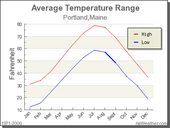
© rssWeather.com
More from the "weather is not climate department". Emphasis below mine. And it is having an effect not only on crops but
tourism in the Northeast US. - Anthony
Statement as of 4:00 PM EDT on July 9, 2009
record event report ... corrected
National Weather Service Gray ME
400 PM EDT Thursday Jul 09 2009
... More record cold weather for Portland Maine...
The temperature at the Portland jetport only reached 58 degrees
yesterday. This set a record for the coldest high temperature on
July 7th. The old record was 59 degrees set in 1961.
To put this in
another perspective... the normal low temperature for July 7th is 58
degrees.
The low temperature on Wednesday was 55 degrees. This produced a
range of only 3 degrees between the high and low temperatures which
is a record for the smallest daily range in temperatures on July
7th. The old record was a 4 degree spread set in 1963 and 1995.
The 3 degree daily temperature range yesterday also tied the record
for the smallest daily temperature range for any day in July. The
record was established on July 16th, 1961 and occurred five more
times before this year.
The average temperature yesterday was 57 degrees... which tied 1961
as the coldest average temperature for July 7th.